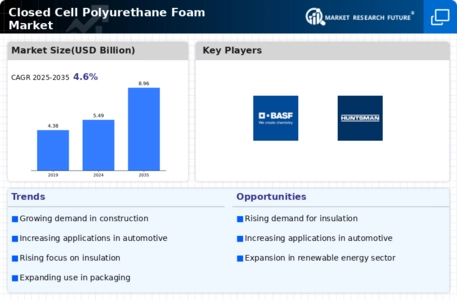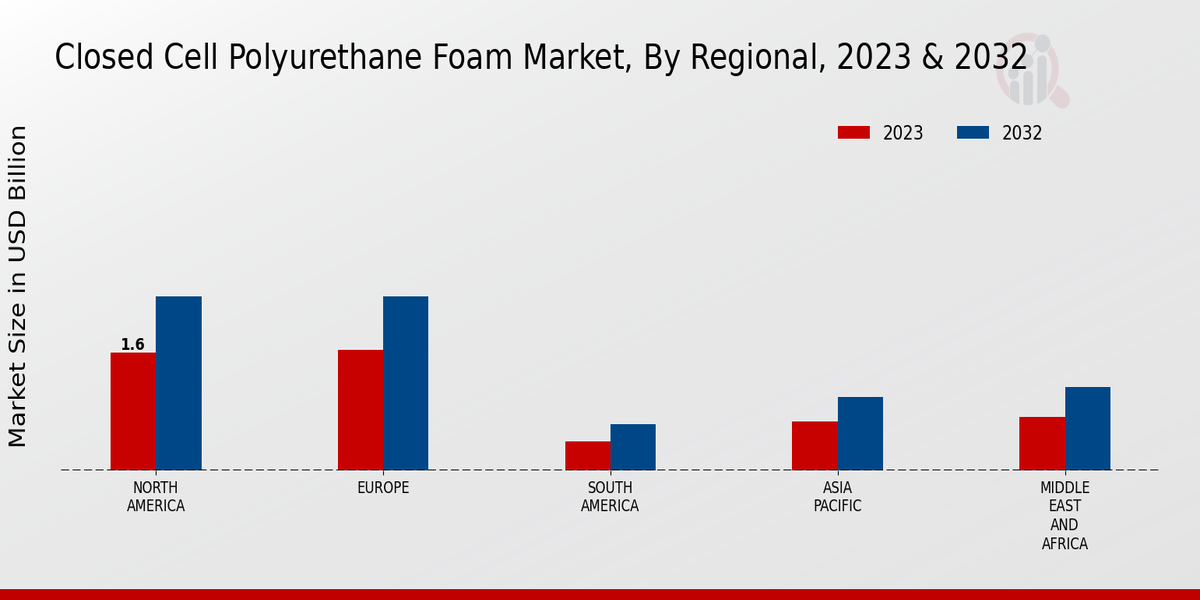Market Growth Projections
The Global Closed Cell Polyurethane Foam Market Industry is projected to experience substantial growth over the next decade. With a forecasted market value of 5.49 USD Billion in 2024, the industry is expected to expand at a compound annual growth rate (CAGR) of 4.56% from 2025 to 2035, ultimately reaching an estimated 8.96 USD Billion by 2035. This growth trajectory reflects the increasing adoption of closed cell polyurethane foam across various sectors, including construction, automotive, and renewable energy. The market's expansion is indicative of the material's versatility and effectiveness in meeting diverse insulation and cushioning needs.
Growing Demand in Construction Sector
The Global Closed Cell Polyurethane Foam Market Industry experiences a notable surge in demand driven by the construction sector. This material is favored for its excellent insulation properties, which contribute to energy efficiency in buildings. As global construction activities expand, particularly in emerging economies, the need for effective insulation solutions becomes paramount. For instance, the market is projected to reach 5.49 USD Billion in 2024, reflecting the increasing adoption of closed cell polyurethane foam in residential and commercial projects. This trend suggests a robust growth trajectory, with the industry likely benefiting from ongoing urbanization and infrastructure development.
Rising Awareness of Energy Efficiency
There is a growing awareness regarding energy efficiency and sustainability, which significantly influences the Global Closed Cell Polyurethane Foam Market Industry. Closed cell polyurethane foam is recognized for its superior thermal insulation capabilities, which help reduce energy consumption in various applications. As governments and organizations worldwide implement stricter energy regulations and standards, the demand for materials that enhance energy efficiency is expected to rise. This shift is likely to drive market growth, as consumers increasingly seek products that align with sustainability goals. The industry is poised to capitalize on this trend, potentially leading to a market value of 8.96 USD Billion by 2035.
Increased Investment in Renewable Energy
Investment in renewable energy projects is likely to bolster the Global Closed Cell Polyurethane Foam Market Industry. Closed cell polyurethane foam is utilized in various renewable energy applications, including wind and solar energy systems, where insulation and protection are critical. As countries worldwide commit to reducing carbon emissions and transitioning to sustainable energy sources, the demand for materials that support these initiatives is expected to rise. This trend indicates a promising outlook for the market, as the industry aligns itself with global efforts to promote renewable energy solutions and achieve sustainability targets.
Expanding Applications in Automotive Industry
The automotive industry is increasingly adopting closed cell polyurethane foam for various applications, thereby driving growth in the Global Closed Cell Polyurethane Foam Market Industry. This material is utilized for soundproofing, thermal insulation, and cushioning in vehicles, contributing to enhanced comfort and safety. As automotive manufacturers focus on lightweight materials to improve fuel efficiency, closed cell polyurethane foam presents an attractive option. The industry's expansion into electric and hybrid vehicles further amplifies this trend, as these vehicles often require advanced insulation solutions. Consequently, the automotive sector is expected to play a pivotal role in the market's growth trajectory.
Technological Advancements in Foam Production
Technological advancements in the production of closed cell polyurethane foam are poised to enhance the Global Closed Cell Polyurethane Foam Market Industry. Innovations in manufacturing processes, such as improved formulations and production techniques, contribute to higher quality and performance of the foam. These advancements not only improve the material's insulation properties but also reduce production costs, making it more accessible to a broader range of applications. As companies invest in research and development, the market is likely to witness an influx of innovative products that cater to diverse consumer needs, thereby fostering growth in the coming years.




